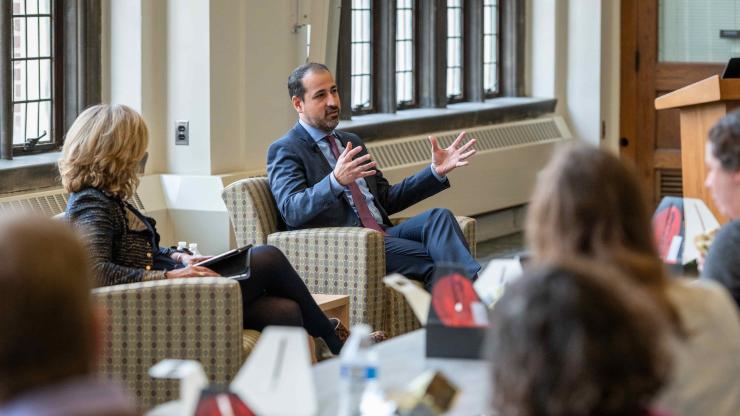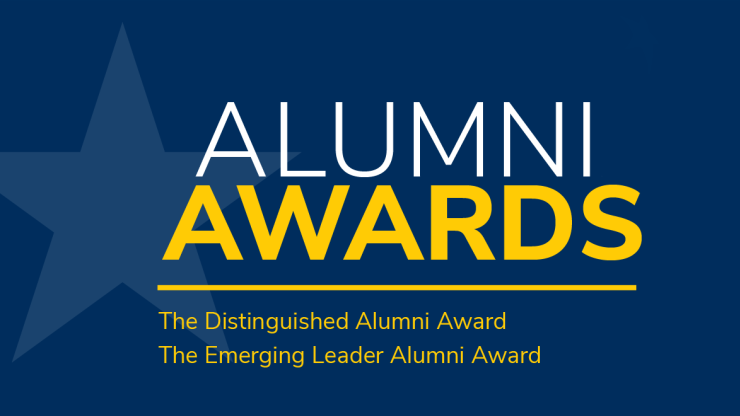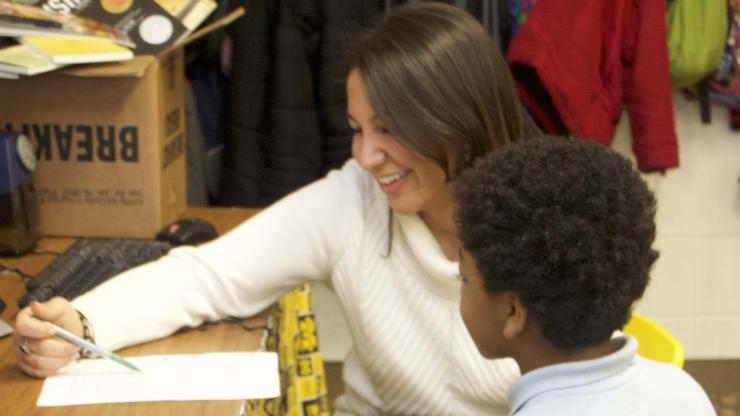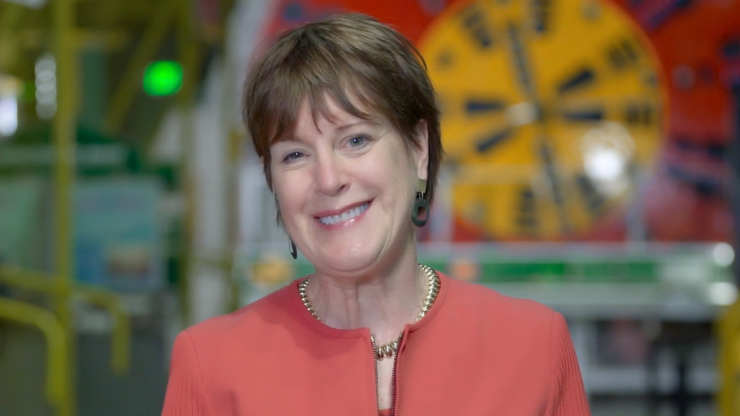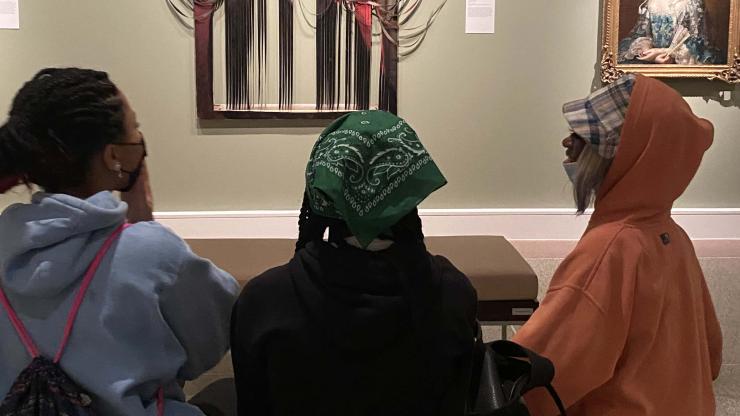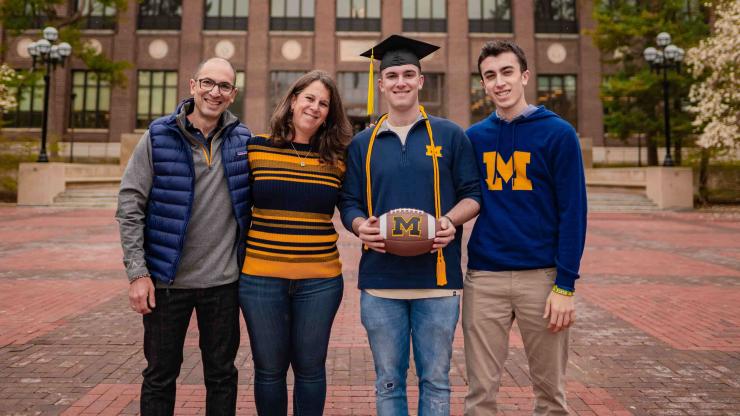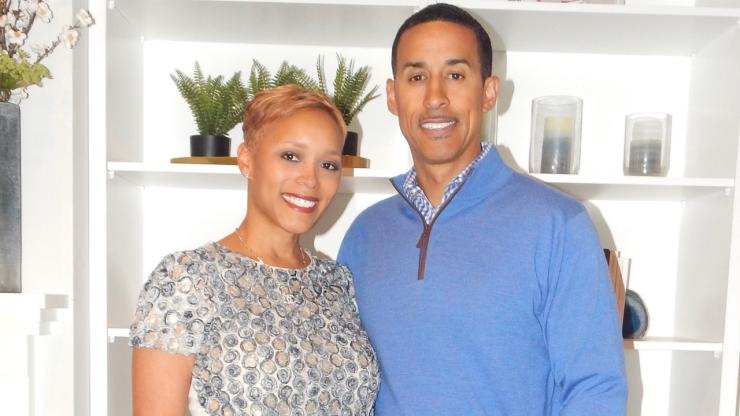
Robots Bring Math and Engineering Lessons to Life
A peek inside Isra Elshafei’s robotics class at The School at Marygrove
The first thing you notice when you walk into Isra Elshafei’s Robotics class is that it doesn’t feel like your run-of-the-mill high school classroom. Instead of desks, there are workbenches, each featuring a big, yellow, retractable power outlet hanging overhead. The workbenches are stacked with electronics components and small, four-wheeled robots. A mysterious x-y-z axis is mapped out in blue tape on the floor. At the back of the room—illuminated by a border of flashing red, blue, and green LEDs—is the “recharge station”: a cozy spot with comfy chairs where students can take time to relax before or after class. Displayed on the wall of the recharge station is a reproduction of Edward Hopper’s Nighthawks—but with robots replacing Hopper’s regular diner customers.
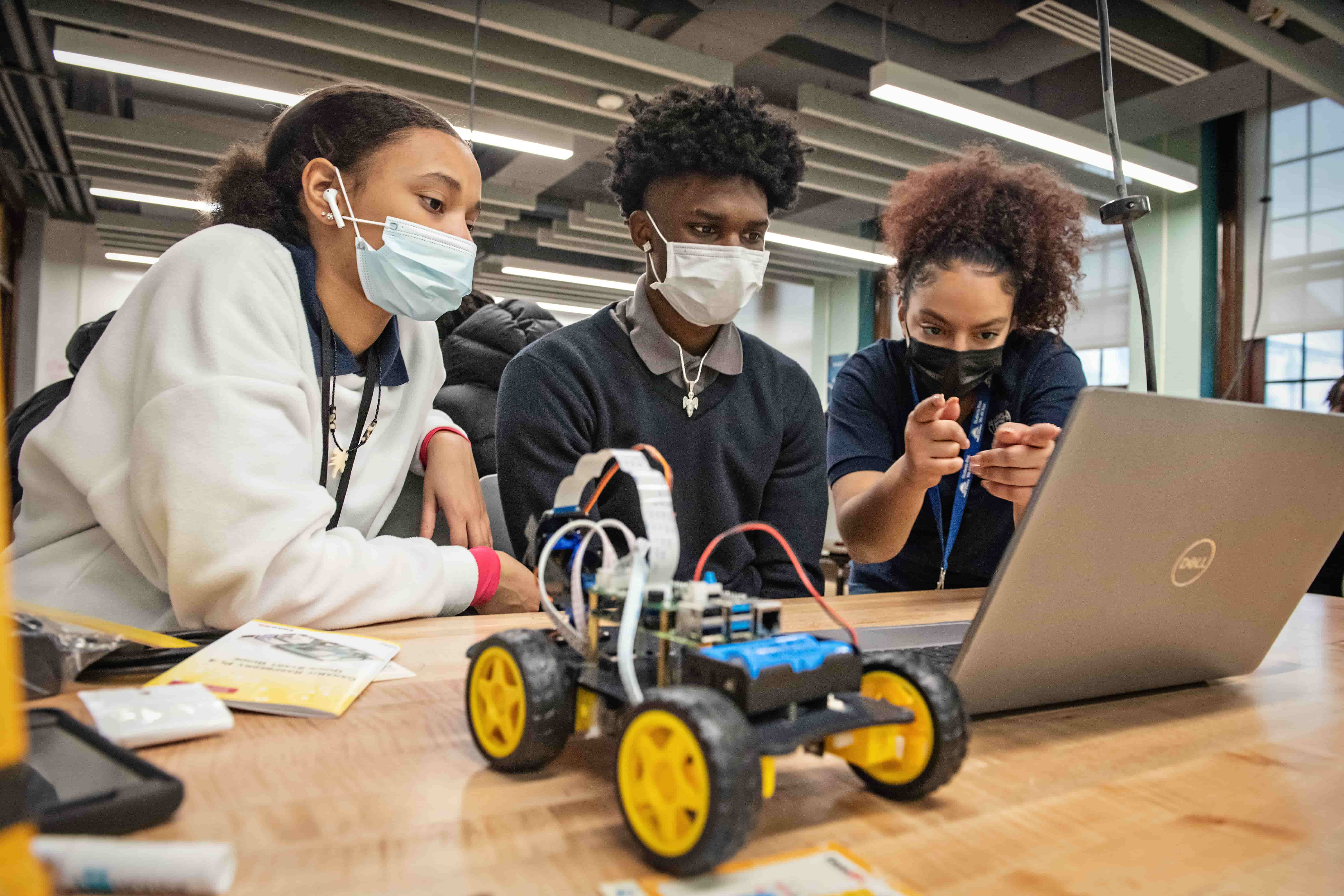
Elshafei (who her students refer to as “Ms. Isra,” or more cheekily, “Ms. Izzy”) is in her first year as a teaching resident at The School at Marygrove (TSM). TSM hosts the School of Education’s Teaching School, where undergraduate and graduate students in the teacher education program learn to use project-based, student-centered approaches by teaching alongside one another as well as expert teachers and university-based teacher educators. Once certified, they are hired at TSM as “teaching residents.” As residents, they teach independently, but remain a part of an intergenerational team that includes expert teachers as supervisors and mentors, and undergraduate mentees.
“This is my first time having my own classroom,” Elshafei says, “and I’m figuring out how to navigate that. However, I’ve been with this group of students since their freshman year. I did my observation time with them [which was in-person before the pandemic], and I did my student teaching with the same group. Now they're my actual students!”
Elshafei’s robotics course is for 11th graders, and is part of TSM’s Human Centered Design and Engineering (HCD+E) curriculum. As a STEM-focused school, each year students at TSM from 9th through 12th grade will take the HCD+E course, which serves as a foundation for the academic work they do as they progress through high school.
Elshafei brings a background in computer programming and a teaching endorsement in mathematics to her instruction. “At this point in the year, we’ve done a lot of programming,” Elshafei says. “We’ve coded a facial recognition system, as well as worked on some mathematics. We’re also working on building robots.”
The course was designed by an interdisciplinary team of faculty and staff from the School of Education and College of Engineering, and teachers at TSM, including Elshafei herself. The curriculum was inspired by the College of Engineering's Robotics 101 course, a class designed to teach foundational engineering skills. The curriculum focuses on learning objectives such as algebraic reasoning, computer programming, building and interacting with robots, and computational thinking.
“I did a lot of the work for the actual lesson plans. It’s been both difficult and exciting, because I was taking on a little more than I had initially expected. However, it's been really fun being able to say, ‘I helped design this curriculum,’ and to get into the details of every class period trying to think about what my kids need to know in order to fully understand these concepts.”
The equipment the class is using—robot kits, Raspberry Pi computers, multimeters, and development kits—are not what some may expect to find in a typical high school classroom. Indeed, this class would not be possible in its current form without some extra help, which is being provided by the KLA Foundation. The KLA Corporation, a global technology company that develops industry-leading equipment and services for the manufacturing of semiconductors, is based in Milpitas, CA, but has locations around the world—including a second headquarters in Ann Arbor, which opened in November 2021. Funding from the KLA Foundation has provided computers, tools, materials, and volunteer support for both TSM’s burgeoning Robotics Club and Elshafei’s new robotics class. Working with these components is a key part of the curriculum and central to students’ learning experience.
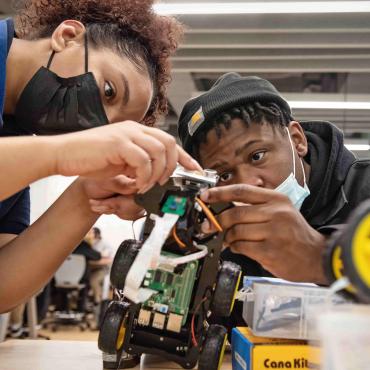
“With the robot,” Elshafei explains, “I was able to tie it into our math unit. These robots are supposed to be line-following robots. The goal, once we get these robots running, is to create vectors for the robots to follow—that’s also why we have an x-y-z axis taped out on the floor.”
Elshafei’s students—she has around 18-20 in each of her four sections—are an animated, enthusiastic bunch. While students often become deeply engaged in the building aspect of robotics, the college-level math can be quite challenging. “The idea is to make it clear that when you’re creating robots, math is a key component. A lot of kids think ‘why do I even need math?’ This is an example. Students are actually able to see it in action. Especially if you’re interested in getting into the engineering field, math is going to come up, and this is how.
“It's been interesting to navigate this space,” Elshafei continues, “because there are quite a few students who may not really be that interested in engineering, so I try to tie engineering to other fields, specifically with the robots. At the start of the school year, I had them do an exploration of a field that they are interested in and see how robots appear in that field—whether it be medicine or cosmetology. It's being used everywhere. It’s so cool, being able to tie that in.”
For one of Elshafei’s last projects of the year, she is planning on taking further advantage of TSM’s connection to U-M. “What we’ll be doing will be in partnership with the Cassie robot at the University of Michigan. We're hoping to plan a field trip to actually see the robot in action.”
Cassie belongs to Michigan Robotics, one of the top-ranked academic research labs devoted to two-legged robots in the world. Cassie, a tough, light, bipedal robot with “eyes,” walks at 11 different gaits forward and backward, 11 sideways gaits, and 11 different gaits for slopes. Loosely modeled on the cassowary, a flightless bird similar to an ostrich, Cassie’s legs have backward-facing knees and attach to a short torso that holds batteries, motors, and computation equipment.
Elshafei has also found some unexpected learning opportunities in her classroom this year. “At the start of the school year, there were quite a few students who didn't know their way around the laptops we use in class as much as I expected them to. I think that just goes to show how our phones have become more relevant than actual computers. So breaking that down and trying to explain interfaces and concepts like that was new information for a lot of students.” In fact, phones now play a legitimate role in the classroom. “The robots will actually end up being controlled by their phones. The robots have a camera attached to them, and they'll be able to see what the robot sees.”
For the lesson Elshafei just completed, she was working with students on how to solve a software problem with the robot’s computer “brain.” It was a workaround that involved downloading software onto a USB card, inserting it into the robot, and connecting it to students’ phones. The project involved several levels of problem solving both for teacher and students.
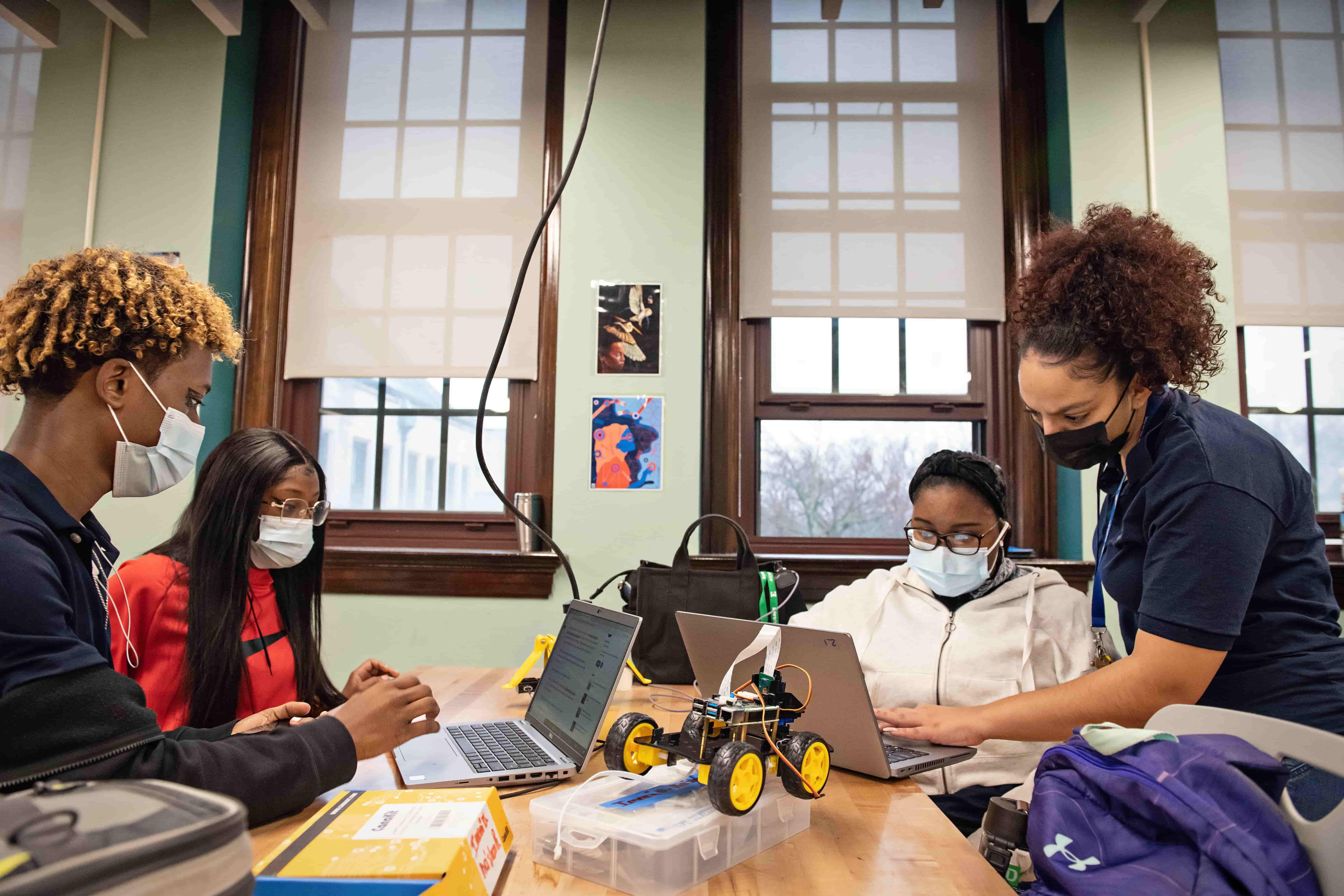
Elshafei explains: “The one thing I've always been with the kids in here is honest. Anytime we've run into issues, I’ll say ‘You know what, we ran into another issue. We're all going to try the solution together like we did today. We're going to see how it goes.’ That's one thing I really appreciate about the kids here. They're always very willing, because it's us exploring together. We're going to try this whether it works or it doesn't.”
When asked if her students were comfortable working on problems where the solution wasn’t always clear, “absolutely,” she says immediately. “At the start of the school year, we did a whole activity on the mindset that we want to go into the school year with. Especially because at the start of the year we worked with coding, and coding can get very frustrating for folks, especially if it doesn't work right away. We worked on this mindset of, ‘Okay, we're going to run into issues—a lot. How do we approach that? How do we handle that? How do we seek support when we run into those challenges?’ Ever since then, I feel like it's been pretty easy. They just don't give up.”
